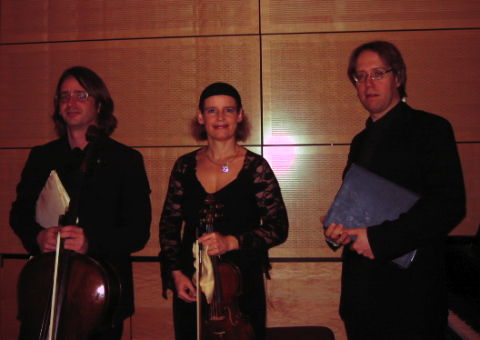|

Lively and Spirited
A performance by Haydn Trio Eisenstadt,
heard by REBECCA SCHMID
The Haydn Trio Eisenstadt has been on an extensive world tour to première newly-commissioned works from its project 'D2H' (dedicated to Haydn), established for the bicentennial of Haydn's death this year.
Based on the composer's famous statement, 'my language can be understood throughout the entire world' (meine Sprache versteht man durch die ganze Welt), the group commissioned six Austrian composers, six composers from other European countries and six composers from outside the continent to write a piano trio in his honor.

Haydn Trio Eisenstadt at Syracuse University. Photo © 2009 Rebecca Schmid
|
Pianist Harald Kosik, violinist Verena Stourzh and cellist Hannes Gradwohl performed the American début of South African composer Bongani Ndodana-Breen's Two Nguni Dances at Syracuse University on Tuesday 17 November 2009 along with two piano trios in C major and E flat major by Haydn, and Schubert's trio in E flat major.
Ndodana-Breen's new commission revealed the difficulties of taking on a project as large in scope as D2H. The ensemble was forced to rely on headphones that contained a metronome in order to play the first part of the trio. Although the musicians had trained with the composer, the complex structure of the piece apparently proved impossible to realize without the help of this device.
The music builds upon rhythms from Ndodana-Breen's native Xhosa culture. The strings are mostly reduced to percussive gestures which are then integrated into a sound that imitates the marimba.
Stourzh played with stamina and admirable dedication, but her instrument did not seem to enjoy the harsh effect of these repeated bowing motions. Kosik held the group together in a rather mechanical fashion. In the second dance, which the group decided to play on its own, the syncopated rhythms lacked authenticity and precision.
The performance nevertheless had gripping moments as the trio reconstructed Ndodana-Breen's dance-like patterns. At times the music came into full swing and created intricate sonorities, but it was hard to accept the validity of either the composition or the performance, given the fact that the instrumentalists were forced to rely on equipment to keep them in sync.
The piece ended on two banged piano chords that drowned out the violin and cello -- causing one to question the purpose of using European instruments to create such an effect.
The rest of the concert was much more credible, if not remarkably so, since the ensemble specializes in the performance of eighteenth and nineteenth century piano trios. It has recorded all of Haydn's trios in the historic hall of the Eszterhazy Castle in Eisenstadt where he conducted, as well as the complete series of the genre by Mozart, Beethoven and Schubert.
Both Haydn trios on Tuesday were lively and spirited. Kosik's clean playing and gentle sound were perfectly suited to the music. Stourzh has a playful approach to leading the group that, while affected at times, provided for interpretations that were musically rich and never static. The group shaped phrases and breathed together with a natural intimacy that defines only the best of chamber ensembles.
The piano trio in C major (H 15/27) was a showcase for the group's spritely musicality and an ability to play with exactitude at very fast tempi. It also revealed a tasteful and effective use of rubato. Kosik effortlessly anchored the group.
The Trio in E flat major features longer, more Romantic melodies that Stourz and Gradwohl executed with great feeling and intensity. The rhythms of the piece had the right bounce and weight. The group was clearly in its element, which provided for a most satisfying concert experience.
The ensemble's upbeat, lively spirit was not as well-suited to the opening movements of Schubert's trio in E flat major. The string players' tendency to shorten notes mid-phrase in order to add buoyancy detracted from the depth of Schubert's music, which must be played with a more weighty legato.
Gradwohl nonetheless took the spotlight as he brought forth a warm, enveloping sound from his cello, particularly in the magnificent Andante con moto. The group produced well-defined phrases that became especially pleasing in the third Allegro movement. They gained even more stride for the last movement, a complex woven structure of several earlier themes from the piece.
The music was rhythmically and dynamically irreproachable, creating a Schubertean mood of longing and melancholy. This was tempered by an exuberance that the Haydn Trio Eisenstadt never seems to lose, even in such profound moments.
Copyright © 20 November 2009
Rebecca Schmid,
Syracuse, USA

Haydn Trio Eisenstadt's current tour of the USA and Canada (8-27 November 2009) includes a performance of Lalo Schifrin's trio at the US Library of Congress in Washington DC at 8pm on 20 November 2009 and the première of American composer William Bolcom's Haydn Go Seek at the New York Metropolitan Museum of Art at 7pm on 21 November. On 29 November the trio appears at the festival Musica en la Casa de los Flores in Madrid, Spain, and, after an appearance in Moscow on 1 December, the group tours China, Korea, Taiwan and Japan, from 5-22 December 2009. Further details from haydntrioeisenstadt.at |
| 
